Sudden onset sickness, tales of poisoned pastries, torrid affairs, and murder for hire. The twists and turns surrounding the story of Joan Robinson Hill’s death are enough to make you dizzy. Did Dr. John Hill kill his wife? Or did a plethora of bad decisions make an innocent man look guilty?
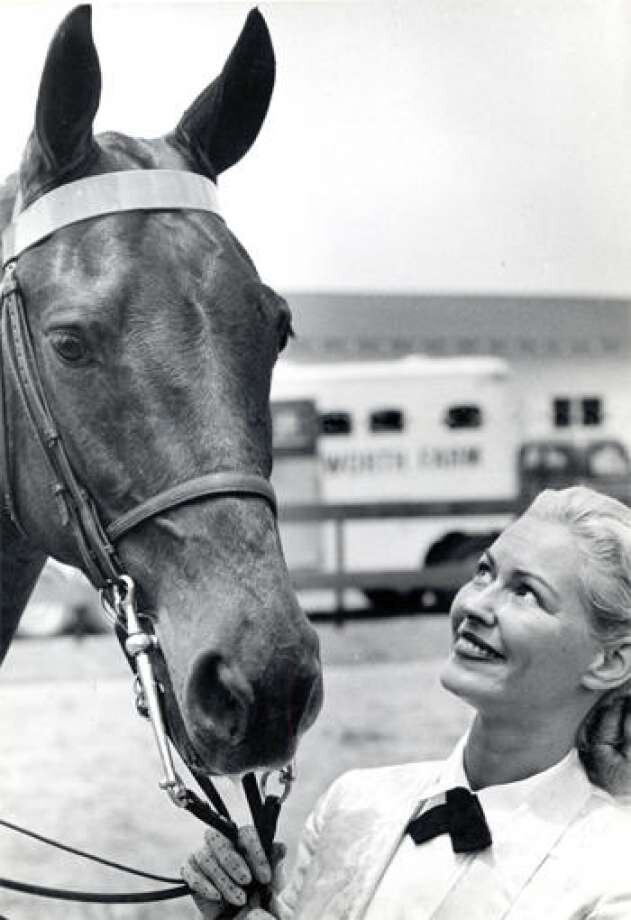
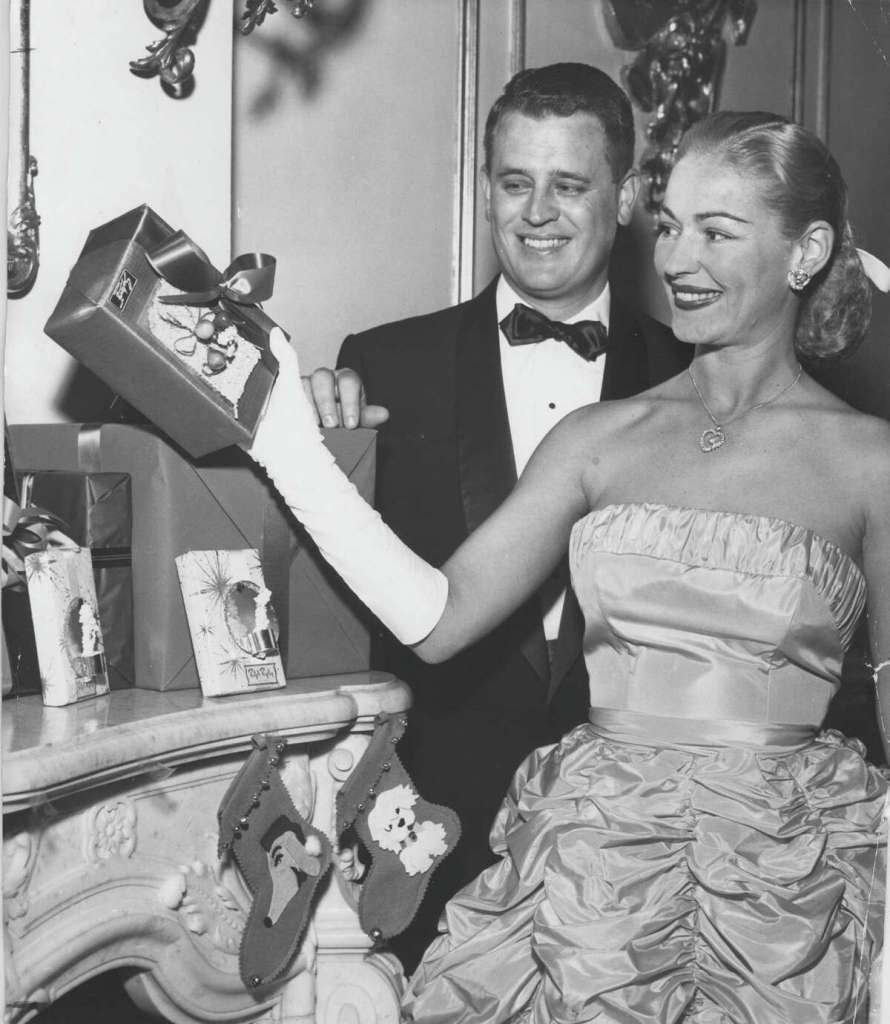
Joan Robinson Hill was adopted in Fort Worth, Texas in 1931 by oilman, Ash Robinson, and his wife, Rhea. Being an oilman’s daughter had its perks; Joan wanted for nothing and began riding horses at the young age of three (3). She won her first third-place ribbon at the age of five (5) and continued to regularly compete, winning first or second place in most of the contests she entered between 1938 and 1945.
She began acting in amatuer productions in college, catching the eye of a talent scout who worked for Metro-Goldwyn-Meyer. The scout offered her a screen test, but her over-protective father, Ash, refused to let her go. It seems as though he was concerned about predatory-types in Hollywood who would take advantage of a young woman like herself. While he may not be wrong about predators in Hollywood, I’m sure Joan didn’t enjoy being told what she could or could not do. No doubt under her father’s thumb, it’s no surprise she had been married twice by the age of 20. Both marriages were not approved by her father and lasted barely over six (6) months. Joan continued to race and her doting father bought her a prize grey mare named Beloved Belinda. She would go on to win over 500 trophies in the 1950s and ’60s with Beloved Belinda and another show horse, Precious Possession.
Life took a new turn for Joan when she met John Hill at a party in either late 1956 or early 1957. She was enamored by his good looks and big dreams of being a doctor. Though the two did not have much in common or share similar interests, the pair got married in a big Texas wedding on September 28, 1957. Her father, Ash, was of course not impressed with John, but this marriage seemed to withstand his judgeful eye.
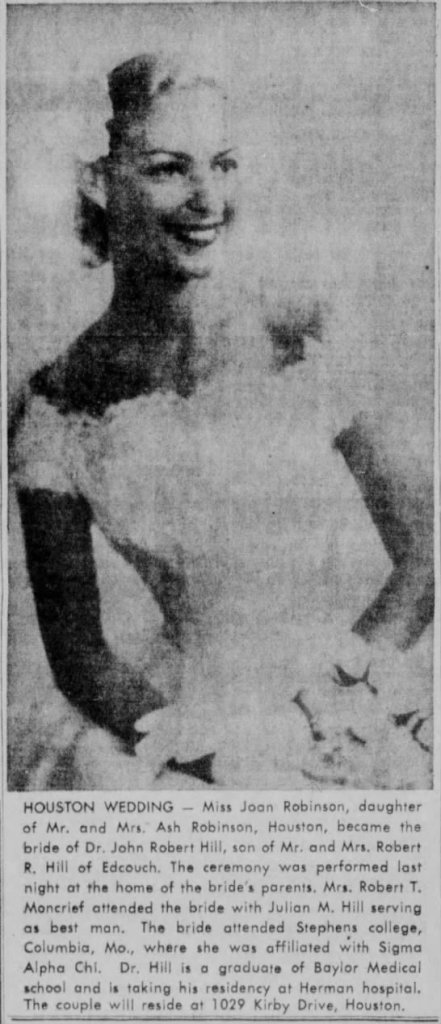
John Hill’s childhood was very different than his affluent wife’s. He was born to farmers in Edcouch, Texas in Hidalgo County, near the Texas/Mexico border. His mother, Myra Hill, insisted that all three of her children be musically inclined, and they began piano lessons at an early age. John and his brother, Jonah, took to the piano and became quite the musicians. He went on to graduate summa cum laude from Abilene Christian College and then attended Baylor College of Medicine in Houston.
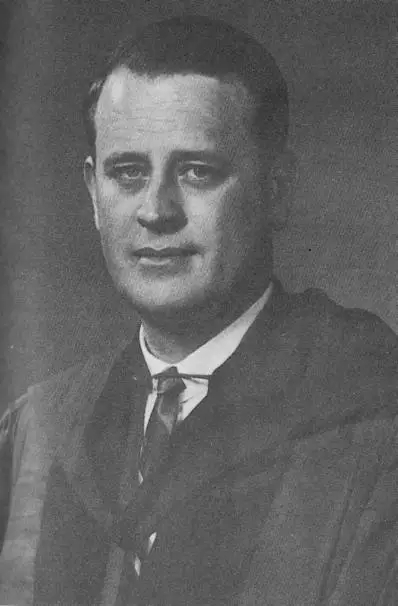
John and Joan lived with her parents, Ash and Rhea, in their first six (6) years of marriage while John completed his residency at Hermann Hospital in Houston. Realizing there was a high amount of competition in cardiac surgery, John turned his sights to plastic surgery. He was a popular student in the residency program, but his career almost ended when he preforated a patient’s bowel during a procedure and stitched him up without repairing the mistake. The patient died from complications due to John’s actions. He managed to get off with a reprimand, and was offered a partnership with well-known surgeon Nathan Roth upon completing his residency.
Joan gave birth to the couple’s only child in June of 1960, a boy named Robert who John called, “Boot.” Joan hated being pregnant and childbirth, and said she wouldn’t be doing it again. I can’t say I blame her, there. While life at home was worth celebrating, work was a different story for John. In 1963, he found himself in hot water once again after leaving a drill bit embedded in a patient’s face after a jaw repair. He failed to mention this to the patient, and when his partner, Nathan Roth, realized the mistake, Hill apologized for the poor bedside manner and blamed his brother’s sudden death on his poor performance. Dr. Julian Hill, John’s brother, overdosed on barbituates in an apparent suicide. During this time, Ash Robinson was still funding Joan’s horse races and all other expenses for the growing family. Ash also purchased Chatsworth Farm for Joan after she expressed an interest in breeding horses and establishing a riding school. The school did well but never became as renowned as Joan hoped it would be.

By 1966, John had found a mansion fit for a surgeon of his stature, and convinced Joan they needed it. The home, built in 1935, was truly a Southern masion and located in the upper-class neighborhood of River Oaks in Houston. You may or may not be surprised to learn that it was daddy dearest, Ash, who paid the $80,000 down payment on the home. Dr. John, however, had no plans to start paying for the mortgage any time soon.
Hill’s medical partner, Nathan Roth, grew tired of Hill’s constant requests to cover for him so he could perform music recitals, and dissolved the partnership in 1967. Hill quickly established his own practice. When he wasn’t working, he was busy pouring all of his earnings into an extravagant music room addition to their already sprawling home. Meanwhile, Ash was still footing all of the other bills. By the time the room was complete, it cost a total of $100,000 ($700,000, today). If Ash wasn’t a fan of John’s to begin with, I can’t imagine how he felt about him by this point. Ten years into the marriage and John is still relying on his wife’s rich family to cover all of their expenses while he dissolves partnerships due to blatant malpractice and spends all of his own money on frivolous items for himself. Quite the catch, Dr. John Hill.
Joan confided in her mother around this time that their marriage was struggling, saying John hadn’t touched her in eight (8) months. John would constantly compain of Joan’s smoking and cursing along with her smell after spending days with the horses in the stables. Joan, in an attempt to save her marriage, quit smoking and started dressing more “glamorously.” I always find these story lines amusing. Dirtbag husband compains about wife’s behavior, attitude, appearance and wife scrambles to appease him. Yes, this was during a time when women were to be seen and not heard. Dinner on the table and a pretty dress on when your husband walks through the door. My first thought is “I’ll give him something to complain about!”
No matter what Joan did to win back John’s affections, he decided enough was enough and filed for divorce in the summer of 1968. It was around this time that John met Ann Kurth when picking up his son Boot from summer camp. Kurth, who had three sons and as many divorces, was a dark-haired beauty and instantly stole the attentions of our wonderful Dr. John. The two soon became involved in an affair while John was still attempting to divorce Joan. Devoted dad, Ash, stepped in and threatened to take everything away from John if he went through with the divorce, including his son, home, and precious music room. Unwilling to lose his free ride, John begrudgingly went back to Joan.
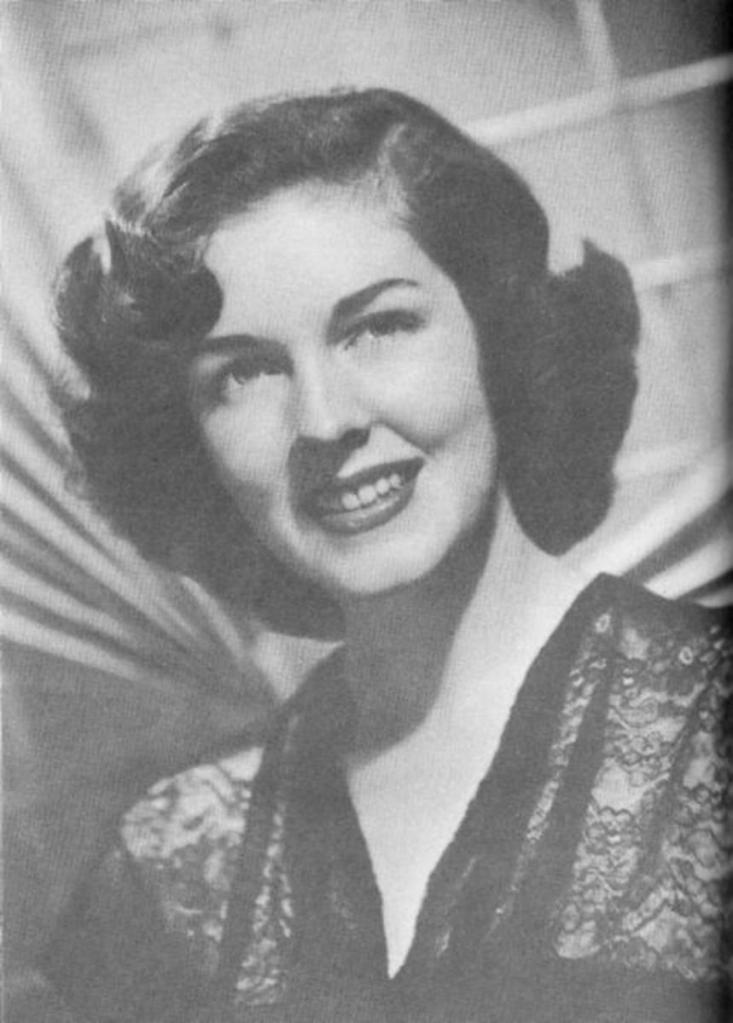
John may have returned home to Joan, but he stilled owned a small apartment where he lived during their separation and continued the affair with Kurth. It didn’t take long before Joan found out about the apartment and continued affair, threatening to take away his son and the “god damn music room.”
The Hills hosted Diane Settegast and Eunice Woolen in their home for a week in mid-March. The women noted later that John would bring home pastries, but insisted on handing out the ones they were allowed to eat. On the afternoon of Saturday, March 15, Diane and Eunice had a conversation with Joan in which she told them that John had given her some sort of pill the previous night that knocked her out. She spent most of the next day in bed after being unable to keep down her breakfast. Seemingly concerned, John said he would go out and get her some medication. By Monday, March 17, Joan’s condition had worsened, but she told her friends she would be fine when they left to return to Dallas.
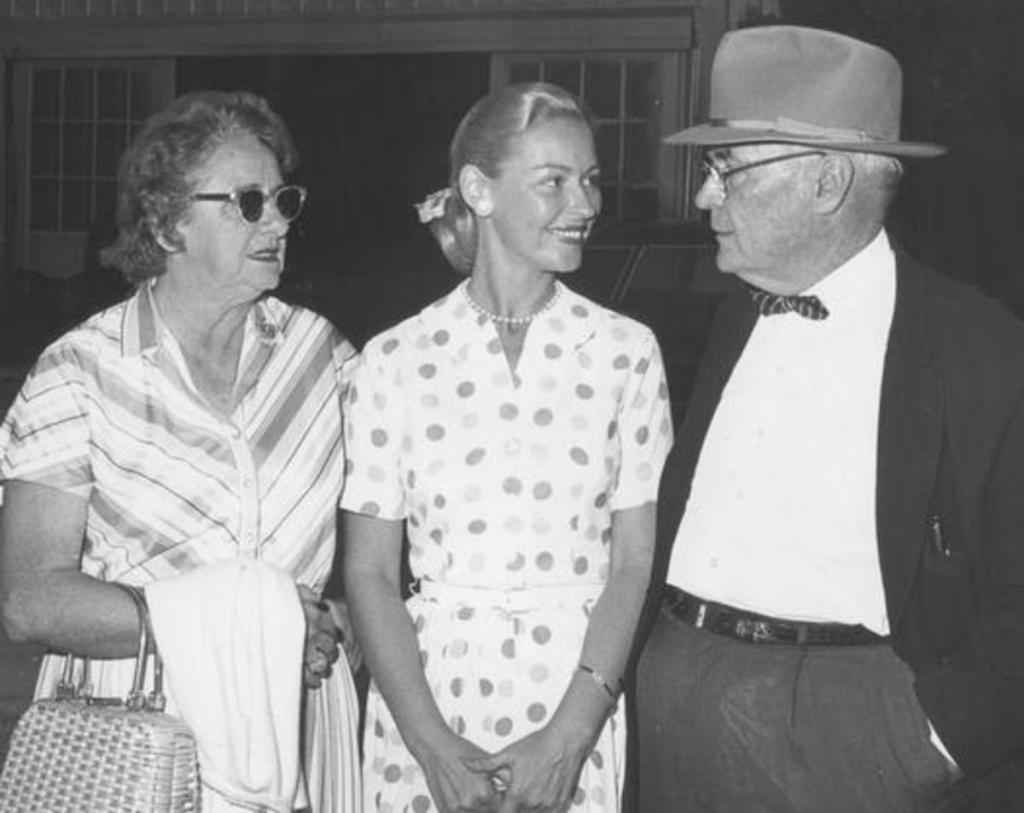
The next day the Hills’ housekeeper, Effie, found Joan laying on soiled bedding because she was too weak to walk to the bathroom. While trying to clean up Joan and her bedsheets, Effie noticed Joan’s face turning blue. She unsuccessfully tried to get in touch with the Robinson’s and John Hill at his office. No one outside of the household was aware of Joan’s condition until her mother, Rhea, arrived that day for a visit. Rhea found Joan in bed, covered in her own vomit, while John Hill stood at the end of the bed. John told his mother-in-law he thought Joan needed to go to the hospital. Seemingly unconcerned, John took his time getting Joan help and chose to drive her to a hospital 45 minutes away from the family home. There were several closer options.
Upon arrival, a nurse took Joan’s blood pressure, which was 60/40. According to medicinenet.com, normal blood pressure for a 38-year-old woman is 112/74. Joan’s doctor initially thought she was suffering from a foodborne illness, but a second diagnosis led to belief she was in septic shock. By 8 p.m. on March 18, Joan was determined to be in severe kidney failure. Despite many attempts to treat her illness, Joan died at 2:30 a.m. on March, 19, 1969.
Texas state law at the time required an autopsy before enbalming or any burial plans could be made. Dr. John ignored the doctor’s explanation of legal needs for an autopsy, however, and had the funeral home pick up Joan’s body within four hours of her death. The funeral home wasted no time and began the enbalming process within an hour of her arrival. By the time the pathologist, Dr. Arthur Morse, got to the funeral home, she had already been enbalmed. This led to difficulty performing the autopsy and Morse couldn’t find any signs of what caused her death, other than a maroon coloration of her pancreas. This single detail led him to rule her death as pancreatitis.
Daddy dearest, Ash Robinson, rightfully questioned the cause of death and began consulting doctors for their opinions and they concluded pancreatitis was unlikely. On the morning of his daughter’s funeral, Ash visited the office of District Attorney Ian Duskin McMaster. He accused Dr. Hill of killing his daughter, explaining the circumstances of her death and drama surrounding the autopsy. McMaster asked the Harris County Medical Examiner to perform more tests prior to her burial. The Medical Examiner concluded that her cause of death was due to viral hepatitis and that no foul play was involved.
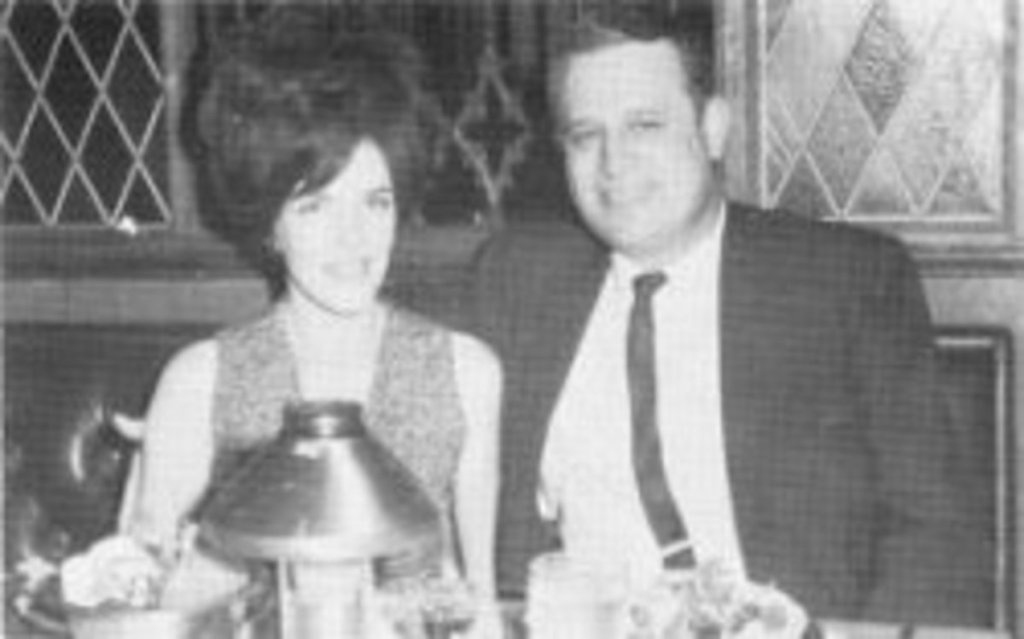
It didn’t take long for Dr. John to move on. He married long-time mistress Ann Kurth on June 16, 1969. Their marriage was tumultuous at best and lasted a mere nine (9) months. In the book Prescription Murder, Ann details a night she and John went out driving around Houston. When they passed Chatsworth Farm, John stated, “that’s where someone lived who doesn’t live anymore.” Ann states that John confided in her that he was involved in his brother’s “suicide,” his father’s “heart attack” and two other individual’s journey to the Great Beyond. The book also details how John attempted to kill Ann by crashing the side of his car into railing on a bridge. When the crash did nothing to impair her, she claims he then tried to inject her with something in a syringe. When a cop car drove up to investigate the crash, Dr. John thew the syringe out the window.
While Dr. John may or may not have been admitting to murders and trying to kill his new bride, Ash Robinson was busy accusing him of poisoning Joan and petitioned the District Attorney, McMaster, to launch an investigation. The case was taken in front of a grand jury a total of five (5) times before he was indicted on charges of “murder by omission.” The charges stated that he had “willfully, intentionally, and culpably” contributed to his wife’s death because he had not given her adequate medical help.
Dr. John’s trial began February 15, 1971. Ann Kurth, his now ex-wife, claimed on the stand that Hill tried to kill her on June 30, 1969. She also testified that he admitted to killing Joan, feeding her pastries laced with infectious bacteria and later injecting her with it. Kurth’s testimony contradicted the murder by omission indictment, and Dr. John’s lawyer, Mr. Richard “Racehorse” Haynes, was granted his request for a mistrial. After working out scheduling issues with some of the witnesses, the second trial date was finally set for November 1972.
Dr. John didn’t let a little murder trial slow him down. He married his third wife, Connie, on June 17, 1971. Meanwhile, his ex-father-in-law was still waiting to see him behind bars for the murder of his daughter. The trial would never begin, however, because Hill was killed on September 24, 1972 in his Houston mansion in front of his wife, Connie, and son, Boot. The man who shot Hill repeatedly stated during the incident that it was a robbery.
A convict named Bobby Wayne Vandiver was arrested in connection with Hill’s murder, but was killed in an unrelated event in Longview, Texas before his trial. Two other accomplices, Marcia McKittrick and Lilla Paulus, were indicted and later charged 10 and 35 years, respectively. McKittrick was paroled after 5 years. Paulus died of breast cancer while serving her sentence in prison in Gatesville, Texas. Many believed Ash Robinson was involved in setting up Hill’s murder, and his wife Connie, and mother Mya Hill, filed a wrongful death lawsuit against Robinson in 1977. It was determined that Robinson had nothing to do with Hill’s death.
Ann Kurth went to on write her book, Prescription Murder, and owned a clothing boutique in Wimberly, Texas, until her death from an anuerysm in 1990. She stated throughout the remainder of her life that she didn’t believe John Hill was really dead and lived in fear that he would come after her.
In 1980, officials came out with more information stating they believed Joan Hill actually died from toxic shock syndrome, commonly associated with improper use of tampons.
Several other books were made about the case, along with a movie in 1981 called Murder in Texas, starring Farrah Fawcett as Joan Robinson Hill and Sam Elliot as John Hill.
Joan and John’s son, Robert, decided to sell the family home with the cooperation of grandfather, Ash, in 1981. The house was estimated to be listed for around $1.75 million and funds from the sale were placed in a trust fund for Robert to receive at age 33.
Resources
What Lies Beyond: https://whatliesbeyond.boards.net/thread/3468/march-1969-money-murder-texas
Chron.com:
https://blog.chron.com/bayoucityhistory/2012/09/40-years-later-dr-john-hills-scandalous-saga/
Newspapers.com:
https://www.newspapers.com/clip/823944/robert-hill-sells-home-reconciles-with/
UPI.com:
https://www.upi.com/Archives/1980/11/24/Blood-money-and-toxic-shock/8198343890000/

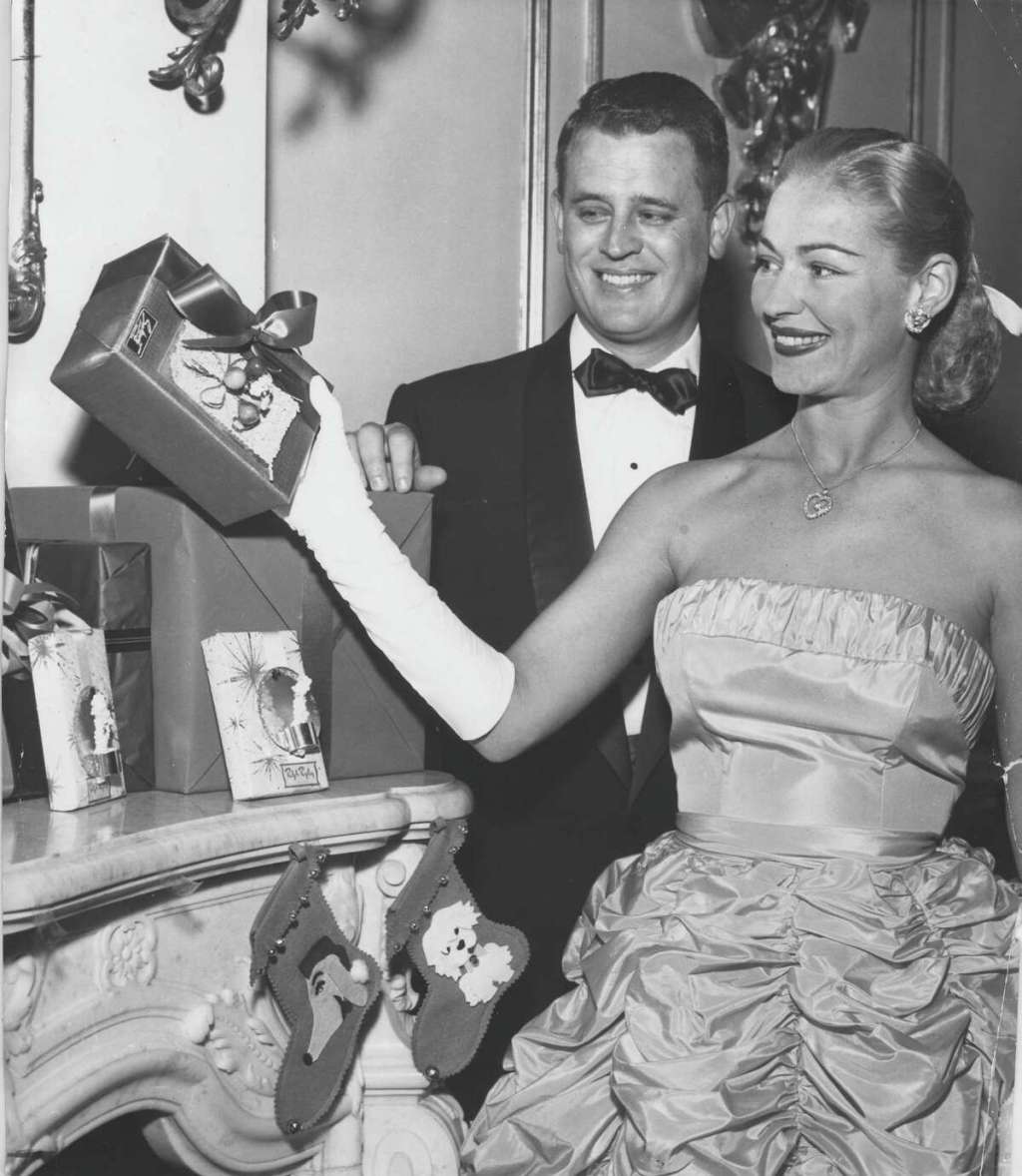
1 thought on “Case Blog – The Death of Joan Robinson Hill”